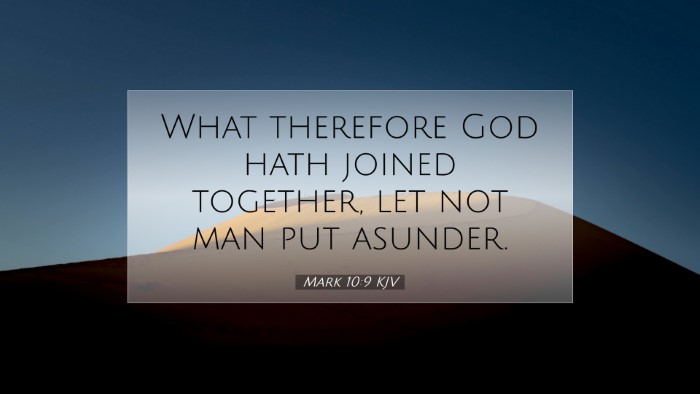Commentary on Mark 10:9
Verse Reference: Mark 10:9 - "What therefore God hath joined together, let not man put asunder."
Introduction
Mark 10:9 encapsulates a profound teaching on the sanctity and permanence of marriage within the Christian tradition. This verse comes as part of Jesus' response to the Pharisees' question regarding divorce. Within this commentary, we will explore the insights from esteemed public domain scholars such as Matthew Henry, Albert Barnes, and Adam Clarke, offering a multifaceted understanding of this crucial biblical principle.
The Context of the Verse
Historical Background: In the time of Jesus, divorce was a contentious issue. The Pharisees sought to test Jesus by asking whether it was lawful for a man to divorce his wife for any cause. Jesus directed the discussion back to God's original design for marriage, highlighting the commitment and covenant involved.
Matthew Henry's Insight: Henry emphasizes that the question of divorce reflects man's heart and the cultural attitudes towards marriage during Jesus' ministry. He points out that Jesus' answer returns to the creation narrative, where God instituted marriage as a divine union. This underscores the sacred nature of the marital bond.
Albert Barnes' Commentary: Barnes elaborates on the word "joined," indicating that it refers to a divine act initiated by God himself. He suggests that for a couple to be joined is a work of God that should not be easily dissolved by human intervention. Barnes stresses that God’s intention is for marriage to be a lasting and sacred commitment.
Theological Implications
Mark 10:9 has significant theological ramifications regarding marriage, divorce, and human relationships. It emphasizes the understanding that marriage is not merely a social contract but a divine covenant.
- The Divine Covenant: As both Henry and Clarke point out, marriage is honored by God. The covenant established in marriage is considered sacred and reflects the covenant relationship between Christ and the Church.
- Human Responsibility: The admonition "let not man put asunder" reflects a moral and spiritual responsibility. It serves as a reminder that human actions should align with the divine will, preserving the sanctity of the marital union.
Marriage in God’s Design
Formation of Marriage: According to Clarke, Mark 10:9 reaffirms that marriage is an institution ordained by God, meant for companionship, support, and spiritual growth. The divine purpose entails that the unity established in marriage should reflect God's love and faithfulness.
Spiritual Reflection: Henry posits that the permanence of marriage also serves to mirror the relationship between Christ and His Church, thereby infusing marriage with a deeper spiritual significance that transcends social norms and expectations.
Thus, pastors and theologians are encouraged to promote the understanding that marriage should be approached with reverence and that its breakdown should be treated with great care and consideration of God's original intent.
Practical Applications
Reflecting on Mark 10:9 encourages practical applications for marital relationships within contemporary society:
- Pre-marital Counseling: Pastors should emphasize the importance of pre-marital counseling to prepare couples for the lifelong commitment of marriage, rooted in divine principles.
- Community Support: Churches must cultivate a community that supports marriages, offering resources for couples in distress and promoting unity in the face of challenges.
- Education on Marriage: Educational programs should focus on the theological significance of marriage, encouraging couples to view their relationship through the lens of faith and commitment.
Conclusion
Mark 10:9 stands as a pivotal verse that instructs believers on the sanctity of marriage as ordained by God. Through the insights of biblical scholars, we recognize the depth of this teaching and its applicability to the modern context. As the Church engages with this scripture, it becomes imperative to uphold the institution of marriage as a reflection of God's unwavering love, commitment, and divine purpose.


